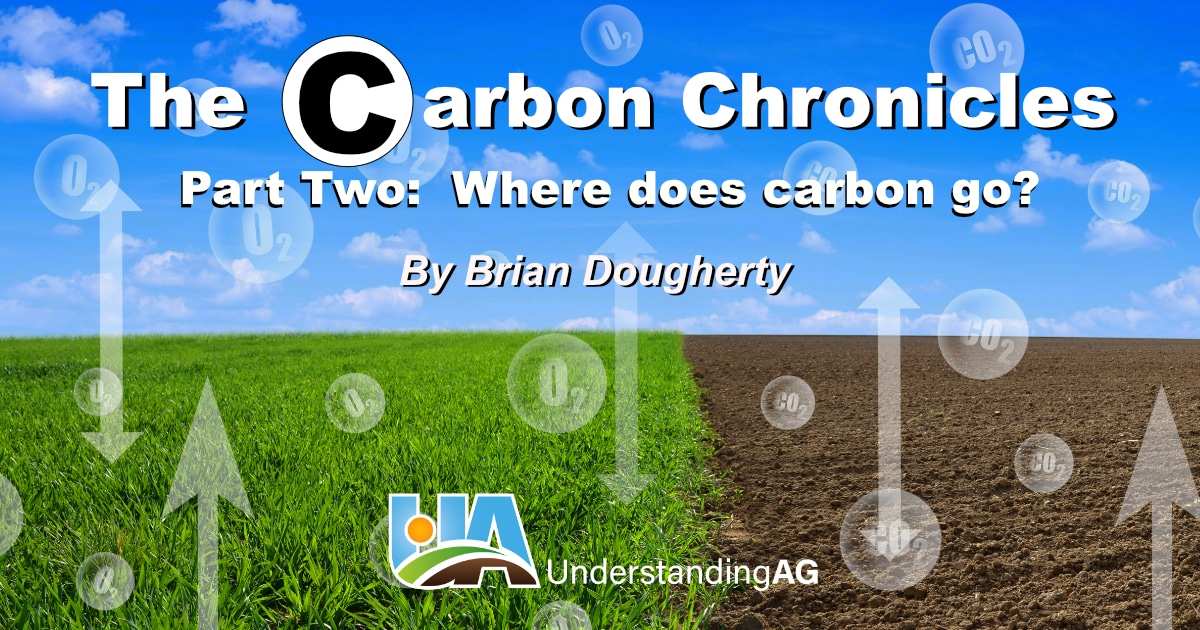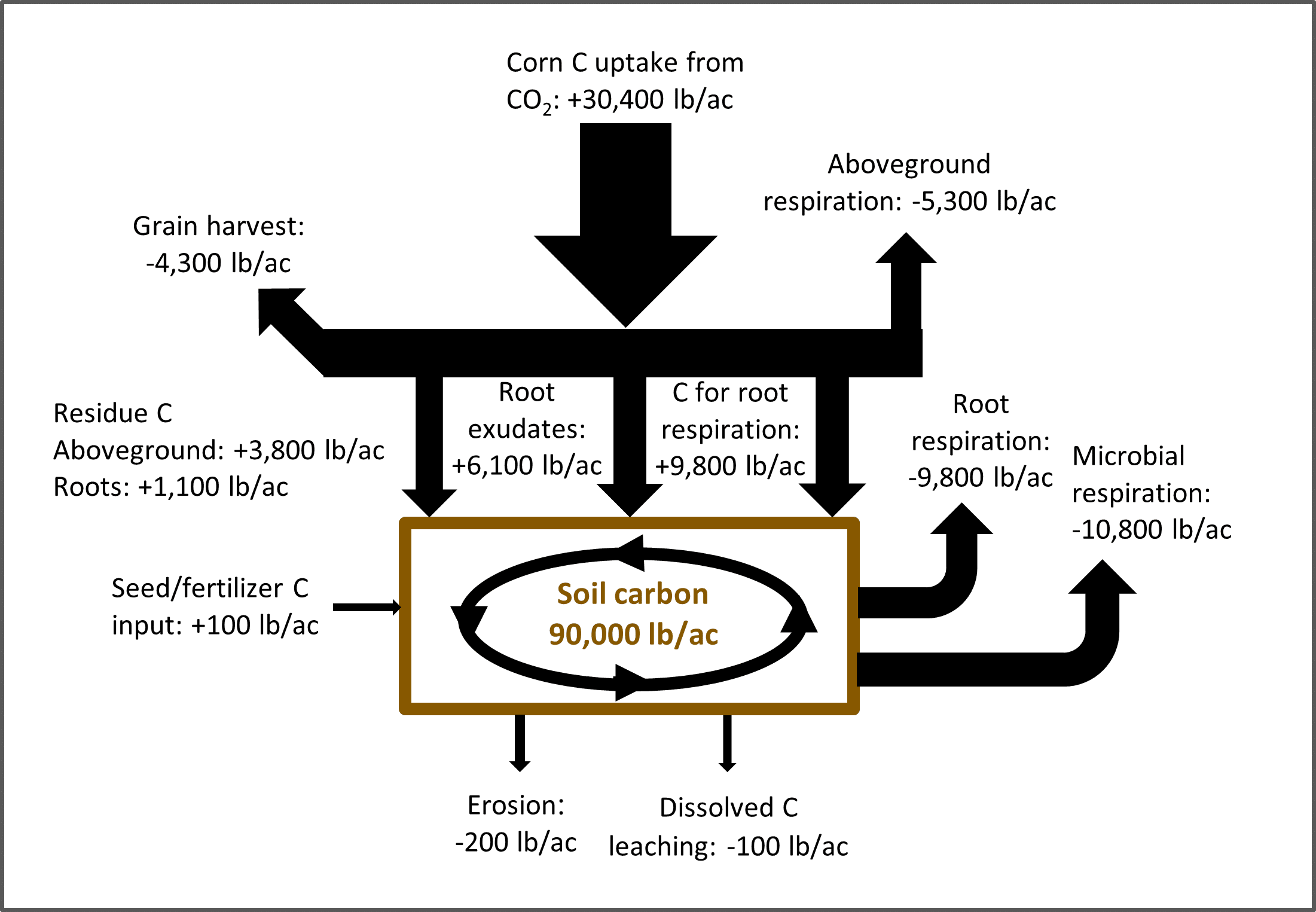I'm a traveler unseen, in cycles I flow, From the air to the earth, far down below. Plants welcome me in their leafy grace, As part of a process, essential to embrace. I dance with the sun, in the...

I'm a traveler unseen, in cycles I flow,
From the air to the earth, far down below.
Plants welcome me in their leafy grace,
As part of a process, essential to embrace.
I dance with the sun, in the atmosphere high,
Yet in oceans and soil, you'll find me nearby.
Roots release me when they exhale,
Guess my name, for I never fail.
Where do I journey, where do I roam?
In this grand cycle, I find my home.
A puzzle of nature, a mystery in prose,
Tell me dear friend, where do I go?
In part 1, we reviewed the important role that carbon plays in the soil. Now let’s focus on how that carbon moves though agroecosystems at the field scale. Below is a basic diagram showing how carbon cycles through a corn field yielding around 200 bu/acre. This is a classic ‘stocks and flows’ diagram that engineers like to create. I confess to being a recovering engineer, but this is a useful way to conceptualize an invisible process that’s happening in crop fields and in pastures. The box represents the carbon stored in your soil. The actual amount will vary depending on your soil organic matter (SOM) percentage and how deep in the soil you measure. Our family farm in Northeast Iowa with 3% SOM in the top six inches has about 67,000 lbs. of carbon per acre in the top two feet of soil. You can measure this in your own soil by running a total nutrient digestion (TND) soil test.
The box is your “storage tank” of carbon in the soil. The arrows represent flows into and out of your tank. The inflow starts with the plant pulling in carbon (CO2) from the atmosphere during photosynthesis. An average corn crop in Iowa is pulling in around 30,000 lbs. of carbon per acre annually. That’s a big number! Where does it all go? Some carbon accumulates in the plant as it grows and ends up as crop residue and root biomass that decays after harvest. Plant biomass is around 40% - 45% carbon on a dry basis. Some carbon is pumped into the soil via root exudates. Root exudates are sugars (liquid carbon) that plants pump into the soil to feed microbes in exchange for nutrients. Another portion of the carbon is used for root respiration.
Now let’s look at the outflows. A portion of the carbon is given off by the plant aboveground as CO2. Soil microbes respire a large portion of the carbon as CO2 while they go about the business of living and dying. The root system of the plant also respires and releases CO2 into the soil and eventually back to the atmosphere. You may have heard people say that soil ‘breathes’. The diagram shows that this is true. Plant roots and soil microbes take in oxygen and give off CO2 just like we do. Another portion of carbon is removed when the grain is harvested. There are other smaller outflows when carbon is lost by soil erosion or dissolved carbon leaches deeper into the soil or out through a drainage line. The actual carbon flows and interactions between plants and soil are much more complex and intertwined but this is a basic model for the carbon cycle of a corn crop. The same process is happening everywhere that plants grow.

The inflow and outflow numbers are averages based on research. The schematic illustrates that all of this carbon is cycling through the plant and soil. It does not necessarily stay in the soil. This is what engineers call a “steady state” system. Subtract the outflows from the inflows and you get zero. The soil organic matter in our box will neither increase nor decrease in this scenario.
Did you spot the missing arrow? It’s the tiny input from fertilizer and seed. We typically add very little carbon to our fields unless we are adding a lot of manure or compost. That is okay because plants can do the work for us, but we need to remember that to increase soil organic matter, we need the flows into the box to exceed the flows out of the box.
Unfortunately, human activity over the past several millennia, and especially the last 150 years, has made the inflows smaller and the outflows bigger. This is why we have lost a large portion of soil organic matter worldwide. We need to reverse this process, but how? It's simple. At least in theory. Do less of the things that make the outflows bigger and do more of the things that make the inflows bigger.
Let’s tackle the outflows first. Soil disturbance makes the outflows bigger. Tillage increases erosion and accelerates organic matter decay. The disturbance and rapid addition of oxygen to the soil creates a huge spike in microbial activity. The microbes use carbon (organic matter) as a food source. The result is a rapid spike in CO2 emissions from the soil. Minimize soil disturbance and leave residue in the field for soil armor to prevent these losses.
Biomass removal also makes the outflows bigger. We have to eat so some removal is inevitable, but we can minimize the negative effects with good management. We need to be very careful with schemes that remove biomass for energy production or other uses. In the long run, we also need to do a much better job of returning carbon and other nutrients to the soil through composting of food waste and humanure to complete the cycle. Composting humanure was a common practice historically, but now it is often contaminated with pharmaceuticals and heavy metals. In nature, all ‘waste’ is recycled. The fact that our humanure is too contaminated to be safely returned to the soil should give us all pause about what we are putting into our bodies and how removed we have become from the cycle of life that sustains us.
Microbial and root respiration are actually good outflows. We measure this as CO2 respiration using a Haney soil test. A larger flow of carbon through roots and root exudates to microbes and back to the atmosphere is a general indicator of a healthier plant and healthier soil. Too little flow of carbon to feed soil microbes is one of the most common problems we encounter on farms.
In part three of this series, we’ll take a deeper dive to look at carbon inflows and examine one key regenerative principle that can supercharge that inflow on your farm or ranch.
The post The Carbon Chronicles – Part 2 appeared first on Understanding Ag.


